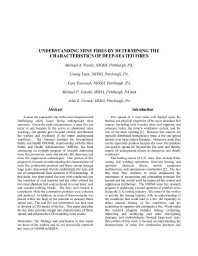Mining Publication: Understanding Mine Fire Disasters by Determining the Characteristics of Deep-Seated Fires
Original creation date: February 2009
A mine fire represents one of the most dangerous and challenging safety issues facing underground mine operators. Given the right circumstances, a mine fire can occur at any location in the active or abandoned mine workings, can quickly grow beyond control, and threaten the welfare and livelihood of the entire underground workforce. The National Institute for Occupational Safety and Health (NIOSH), in partnership with the Mine Safety and Health Administration (MSHA), has been conducting an in-depth program of research addressing mine fire prevention, early and reliable fire detection, and mine fire suppression technologies. One portion of this program is focused on understanding the characteristics of mine fire combustion products and flame spread through large scale deep-seated (firmly established) fire tests and use of computational fluid dynamics (CFD) modeling. In this study, two deep-seated fire tests were conducted; one fire consisted of coal material and the other utilized the two most abundant fuel sources found in a coal mine: coal and wooden cribbing blocks. The fires were burned to completion while the combustion products were collected and analyzed. In addition, an array of thermocouples was placed within the body of the material to measure flame spread rate. The coal fire test information was then used to develop a CFD model of the fire. This paper describes the fire tests, provides insight into characteristics of flame spread, and presents the CFD modeling work results.
Authors: MA Trevits, L Yuan, KA Teacoach, MP Valoski, JE Urosek
Conference Paper - February 2009
NIOSHTIC2 Number: 20035060
2009 SME Annual Meeting and Exhibit, February 22-25, Denver, Colorado, preprint 09-150. Littleton, CO: Society for Mining, Metallurgy, and Exploration, Inc., 2009; :1-9
See Also
- CFD Modeling of Fire Spread Along Combustibles in a Mine Entry
- Fire Control and Suppression
- Fire Response Preparedness for Underground Mines
- Innovative Strategies for Mine Fire Preparedness
- Performance-Based Fire Safety Designs for Self-Escape in Underground Mines
- Remote Mine Fire Suppression Technology
- Responders to Underground Mine Fires
- Smoke, Carbon Monoxide, and Hydrogen Chloride Production from the Pyrolysis of Conveyor Belting and Brattice Cloth
- The Status of Mine Fire Research in the United States
- Water Mist Extinguishment of Pool Fires: A Parametric Approach
- Page last reviewed: 9/21/2012
- Page last updated: 9/21/2012
- Content source: National Institute for Occupational Safety and Health, Mining Program


 ShareCompartir
ShareCompartir
